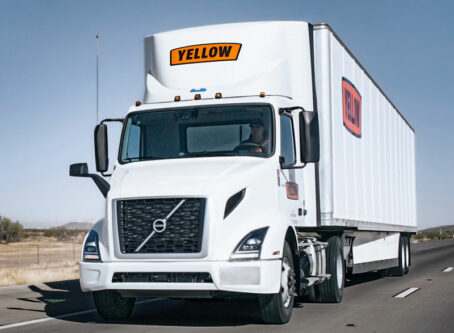USDOT freight facts underscore truck demand, infrastructure needs
Demand for trucks has been steadily increasing over the years and will continue to increase in the foreseeable future. Truck demand combined with a wealth of other freight stats highlight the need for infrastructure funding and can all be found in the U.S. Department of Transportation’s Freight Facts and Figures 2017.
Domestic and international trade
From 2012 to 2015, domestic and international trade (by weight) moved by trucks increased by nearly 7 percent. Analysts expect an increase of more than 37 percent from 2015 to 2045, an average increase of more than 1 percent per year.
Trucks continue to carry more domestic freight than any other mode and will continue to do so in the foreseeable future. In 2015, trucks carried about 43 percent of all domestic freight by tonnage, approximately 2.011 billion tons. By 2045, trucks are projected to transport more than half of domestic freight tonnage and an increase of 163 percent of tonnage compared with 2015.
Half of the tonnage in 2015 moved less than 100 miles. Only 15 percent of freight when calculated by weight was transported more than 500 miles. When adjusted to ton-miles, the numbers begin to change: Nearly two-thirds of freight traveled more than 500 miles and only 5 percent below 100 miles. More than 40 percent of freight ton-miles moved more than 1,000 miles.
NAFTA freight continues to be moved mostly by trucks. However, movement in Canada has slowed down significantly since 2000. Conversely, truck border crossing in Mexico has picked up in the same time frame.
From 2000 to 2016, trucks crossing the Canada-U.S. border decreased by more than 16 percent. Loaded truck containers crossing the northern U.S. border decreased by 10 percent. Although down since 2000, there has been a moderate increase in both categories from 2010 to 2016.
Meanwhile in Mexico, total truck border crossing increased by nearly 30 percent from 2000 to 2016 and went up almost 75 percent for loaded truck containers.
Truck travel and speeds
As of 2016, longer combination vehicles are permitted mostly in the Northwest. A few locations in the Midwest, including Kansas and Oklahoma, allow doubles up to and over 100 feet and triples. One highway through New York and one in Florida allow doubles up to and over 100 feet, but no triples. Click here for a larger image of the below map.
To no trucker’s surprise, the vast majority of heavily traveled routes for long-haul truck traffic are on the interstates. A few exceptions include Route 99 in California and roads near border connections. But if truckers are complaining about congestion on those interstates today, wait until 2045. Below are two maps: truck traffic in 2012 and projected truck traffic in 2045:
Major truck routes are also expected to change by 2045. The maps below show the change of major truck routes in 2045 compared to 2012:
Average truck speeds have trended downwards on many metro area interstates. From 2012 to 2015, average truck speed in Atlanta slowed down from 60.51 mph to 58.79. Similar reductions have been seen in Boston, Chicago, Dallas, Detroit, Houston, Los Angeles, Miami, New York, and Philadelphia.
Speeds were reduced even more at the top congested freight-significant locations. Areas in Houston account for four of the top 10 most congested locations:
- Atlanta: I-285 at I-85 (north) – 39.79 mph (average speed)
- Chicago: I-290 at I90/I-94 – 26.95 mph
- Fort Lee: I-95 at Route 4 – 36.17 mph
- Louisville: I-65 at I-64/I-71 – 43.93 mph
- Houston: I-610 at US 290 – 38.20 mph
- Houston: I-10 at I-45 – 42.37 mph
- Cincinnati: I-71 at I-75 – 47.19 mph
- Houston: I-45 at U.S. 59 – 38.54 mph
- Los Angeles:Route 60 at Route 57 – 44.76 mph
- Houston: I-10 at U.S. 59 – 43.31 mph
Planning multiple trips can be difficult with a large variance in travel time for just one trip. Below is a chart of the differences between the minimum and maximum trip time for certain city pairs. Some trips allow for easier planning with a minimum/maximum differential of less than 10 minutes. Other trips can be a nightmare when drafting a tight schedule, such as two-hour difference with the Philadelphia-New York trip:
Economy
Overall, employment has increased significantly compared to 2010. Employment of heavy truck drivers was at 1.577 million in 2000, sank to 1.466 million in 2010, and rose to 1.704 million in 2016. This suggests the economy is rebounding to pre-recession levels.
Despite fewer establishments and employees in the trucking subsector, revenue was up from 2007 to 2012. In that time frame, truck establishments decreased by 7 percent and employees were reduced by nearly 10 percent. Consequently, payroll went down by less than 1 percent. However, revenue increased by 9 percent. A deep recession and the slow recovery period may explain part of those numbers.
Truckers are delivering products to more people. With a population increase of 14.5 percent since 2000, there are 20.2 percent more households.
Top commodities by weight in 2015 (millions of tons):
- Natural gas, coke, asphalt: 2,647
- Gravel: 1,820
- Gasoline: 1,227
- Cereal grains: 1,099
- Nonmetal mineral products: 1,073
- Fuel oils: 1,054
- Coal: 1,001
- Crude petroleum: 903
- Other foodstuffs: 704
- Waste/scrap: 653
Top commodities by value (billions of 2012 dollars):
- Electronics, $1,673
- Motorized vehicles, $1,467
- Mixed freight, $1,458
- Machinery, $1,148
- Gasoline, $1,129
- Natural gas, coke, asphalt, $938
- Pharmaceuticals, $903
- Fuel oils, $853
- Miscellaneous manufacturing products, $791
- Other foodstuffs, $710
Infrastructure
Infrastructure may be less than ideal today, but there has been some improvement over the past 15 years. According to the International Roughness Index, rural road interstate road conditions have improved by 13.8 percent, and urban interstate road conditions have improved by 22.6 percent
Bridges also are holding up better compared to 2000. Only 9 percent of bridges are considered structurally deficient, down from 15 percent in 2000.
From 2010 to 2015, more than 430,000 trucks have been added to the nation’s roadways, a total of more than 11 million trucks and a 4 percent increase. Trucks account for 4.2 percent of all vehicles on the road.
The U.S. DOT’s freight stats also included a section on the truck parking problem, citing Jason’s Law survey results.
Inspections and compliance reviews
Commercial motor carrier compliance reviews have been mostly consistent that past couple years. Last year, more than 7,500 compliance reviews were conducted, with more than 70 percent receiving a “satisfactory” or “conditional” rating. Only 6 percent received an “unsatisfactory” rating and the remainder receiving no rating. Numbers were close to the same in 2014 and 2015.
Roadside safety inspections have increased in the 16-year period, but are actually down slightly in a two-year period. More than 3.4 million inspections were conducted last year, up nearly 40 percent since 2000 but down nearly 6 percent from 2014. More than half of inspections yielded violations.
Driver inspections in 2016 resulted in an out-of-service violation rate of 4.9 percent. OOS violations as a percentage has steadily decreased since 2000, when the rate was 8 percent. Approximately 20 percent of vehicle inspections resulted in an OOS violation.
For more freight facts, check out the full report here.









